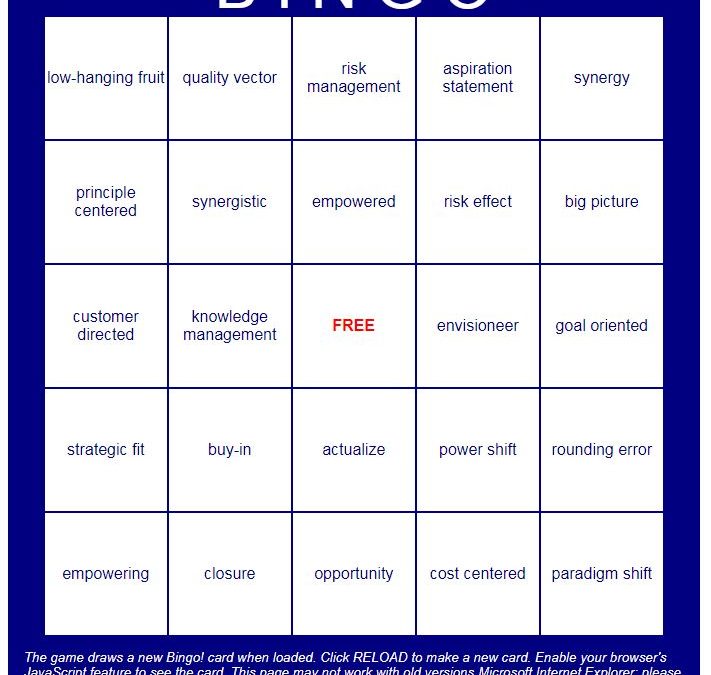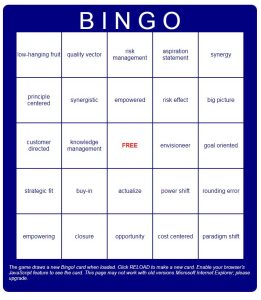
by Ken Krause | Sep 20, 2017 | Blog
Having worked across a number of industries during my career, I feel pretty safe in saying no industry loves it jargon (and acronyms) like healthcare. The general technology industry probably comes in a close second, but for pure technical mumbo-jumbo you can’t beat healthcare.
Part of it, I think, is that the healthcare industry is filled with a lot of smart people. Because of that, everyone feels like they have to sound like the infamous “smartest person in the room.” So they load up their content or their speeches or even their everyday conversations with a lot of jargon designed to give that impression.
Nowhere does that become more apparent than when I go to check the website of a new client or prospect to start familiarizing myself with their business. I can’t tell you how many times I’ve come away after reading page upon page asking “But what do you do?”
Yes, you’re open and interoperable. Yes you follow evidence-based best practices. Yes, your methodology is transformative and sustainable. Yes, your subject matter experts have a wealth of experience in solving the toughest problems facing the industry. But again, what do you do?
If I, who has an employment-based incentive for comprehending your inscrutable jargon can’t figure out what you’re trying to say, what do you think happens to the typical prospect doing a fly-by? They see a bunch of words and terms they’ve heard 100 times before. They try to determine if they’re in the right place, looking at the right company.
But if it doesn’t come to them immediately, odds are they just move on. You lose.
Keep it simple
You’ve probably heard this quote, often erroneously attributed to Albert Einstein: If you can’t explain it simply, you don’t understand it well enough. Ol Al may not have said it, but there is a lot of truth to it nonetheless.
I know this from personal experience. Thanks to my work here at Amendola Communications, I have had the opportunity to speak with some incredibly smart, accomplished people. They are the kind of people who are leading all of healthcare toward amazing new discoveries and ways of working.
While they come from different backgrounds and have expertise in very different areas, the one trait they all had in common was their ability to get their point across in a way that the average person could understand.
Some were talking about advanced analytics and machine learning. Some were talking about the nuances of health insurance. Some were literally talking about curing cancer. But you never walked away from the conversation wonder what the H-E-double hockey sticks they were talking about.
Instead, you walked away energized and inspired. Not to mention excited about the possibilities for the future and how their companies were creating them.
Learning to speak/write plainly
Becoming a clear communicator like that isn’t easy. It actually takes a lot of work to make your communication sound effortless yet on-target.
The first step, quite honestly, is not being afraid that people won’t think you’re smart if you don’t pack your content or your spoken words with industry jargon. In business there are no points awarded simply because you sound “smarter” than everyone else. The money goes to the people who show they understand the problem and how to solve it.
Once you’ve bought into that philosophy, start looking through your current content, perhaps with a Business Buzzwords Bingo card in hand. If you find you are winning within the first three paragraphs of a piece of content, especially your company website, you know you have some work to do.
paragraphs of a piece of content, especially your company website, you know you have some work to do.
Now listen to speeches from great communicators or read materials from a technically sophisticated consumer product. Whether you were a fan of Ronald Reagan’s or not, the man knew how to sell an entire nation on a concept. Is what you’re doing any different? Or as my colleague Michelle Noteboom points out, see how Donald Trump approaches the same challenge. You may not like what he says, but you must admit he has a way of stating his positions simply.
Car companies, especially the high-end ones, offer a great example of plain speaking. Even when they’re talking technical specs, they do it in a way that focuses on why you should care.
Apple has always had a good handle on that as well. While everyone else in the industry was talking about jitter rates and Hz-related info, they were telling how you could get 1,000 songs in your pocket. Everyone can understand that.
There’s the key. It’s not about the bells and whistles in your product. No one cares how much effort you had to go through to develop it. That’s your problem.
What they want to know is what’s in it for them. The easier you make it to understand that, the more intrigued they will be.
Read my lips: no more jargon
Well, very little anyway. It is healthcare, after all, and there are technical terms that must be used at times. But if you try to ensure that any jargon you use is essential to explaining your position, and that there’s no other way to say it, you’ll likely find prospects staying longer and going deeper on your website. And more willing to engage with you all the way to a sale.
by admin | Aug 29, 2017 | News
SCOTTSDALE, Ariz. Aug. 29, 2017 Amendola Communications, an award-winning healthcare marketing and public relations agency, announced today that It’s Never 2 Late (iN2L), the leader in providing person-centered engagement, content and technology solutions for seniors, has selected Amendola Communications as its agency of record. Amendola will provide a range of public relations and content services that promote iN2L as a pioneer and innovator whose mission is to make life worth living for older adults by enabling them to connect, engage and enjoy life leveraging technology.
Previously, iN2L engaged Amendola to elevate its social media presence. The firm successfully executed a program that generated the following results for iN2L in the first six months: 28% new page likes on Facebook; 17% new Twitter followers and 30% new LinkedIn connections.
“I have always been impressed with the Amendola team’s in-depth knowledge of the healthcare IT, long-term care and resident/patient engagement space, as well as their strong commitment to results-oriented client service,” said Tom Bang, chief executive officer of iN2L. “They proactively hit the ground running with several earned article placements in tier one press, multiple media interviews, and strategic guidance from a team of six senior level executives. We’re delighted to be working with them again.”
iN2L works with over 2,000 senior living communities including independent living, assisted living, nursing homes and adult day programs in all 50 states and three countries. iN2L integrates the hardware, software and media with personalized educational and therapeutic content necessary to allow virtually any person with any interest in using a computer, regardless of background, physical or intellectual abilities, to do so pleasurably, engagingly and without frustration.
“A repeat client is a testament to the value we bring to our partnerships,” said Jodi Amendola, CEO of Amendola Communications. “We look forward to advancing iN2L’s mission in the marketplace and to working once again with industry leaders, Tom Bang and Jack York.”
Amendola Communications will provide public relations and marketing communications services, including social media programming, strategic counsel and media relations. The agency will also be responsible for delivering a range of content demonstrating the thought leadership and expertise of iN2L’s subject matter experts, including bylined articles, blog posts, press releases and other communication materials.
About It’s Never 2 Late
It’s Never 2 Late (iN2L) develops digital engagement technology for senior living community residents, with over 2,500 installations in the United States and Canada. The company’s picture-based, touchscreen interface provides easy connectivity to the Internet, regardless of users’ physical and cognitive abilities. iN2L’s media library offers 4,000 social, educational, spiritual and gaming content options. For more information, visit www.in2l.com.
About Amendola Communications
Amendola Communications is an award-winning national public relations, marketing communications, social media and content marketing firm. Named one of the best information technology (IT) PR firms in the nation by PRSourceCode for four years running, Amendola represents some of the best-known brands and groundbreaking startups in the healthcare and healthcare IT industries. Amendola’s seasoned team of PR and marketing pros delivers strategic guidance and effective solutions to help organizations boost their reputation and drive market share. For more information about the PR industry’s “A Team”, visit www.acmarketingpr.com, and follow Amendola on Twitter and LinkedIn.
Media Contact:
Marcia Rhodes, Amendola Communications, mrhodes@acmarketingpr.com

by Ken Krause | Aug 9, 2017 | Blog
Everyone loves a great customer success story. You can talk features and benefits in the abstract all day, but nothing brings home the concept that those features and benefits will actually solve the problem you’re trying to address than hearing it already did the same for someone else. It’s the ultimate sales tool.
Of course, getting customers to agree to participate in a success story isn’t always easy. Some aren’t allowed to participate by corporate edict. Others are afraid to because they don’t want to admit that anything in their organizations was ever not hunky-dorey. Some just don’t want to spend their time that way.
So when a customer does agree to tell their story about their experience with your organization, you definitely want to make the most of the opportunity. Here are a few tips that will help you make that happen.
Start with your organization’s contact(s)
This is a step that often gets skipped. Someone fills out a form, usually in a hurry, and assumes that’s all the background the writer will need to interview the customer. Not true!
It’s always helpful to speak with the people who work with the customer every day salespeople, customer service, tech support, trainers, or whoever is most germane to the story you want to tell. They often have perspectives to share that they wouldn’t think to add to a form but that come out in the course of a conversation. Especially if the person doing the interview is experienced at drawing out those types of thoughts.
Gather the background from the internal contact and let that help guide the customer questions.
Always speak to the customer
Some people in the organization (read: salespeople, usually) may be reluctant to have anyone speak directly to their customer for fear the new person will do something crazy that hurts the relationship. Not sure exactly what they’re expecting, but if you’re working with professionals there is very little chance of that happening.
It is important for the writer to speak to the customer because that is the best way to get the “real” story. I can’t tell you how many times I’ve been on an interview and the story the customer tells differs substantially from what the company insider thought had happened. It’s not that either is untrue it’s simply a matter of perspective, and what is important to each.
Ultimately, you want it to be the customer’s story, and it’s the customer who has to give final approval. Best to get the story they think you’re there to write directly from them. Trust me, it will save a lot of time on the back end.
Prepare good questions ahead of time
Once the conversation with the customer is set up, it’s important to prepare a very targeted set of questions to draw out the story in vivid detail. You can start with a template, but you really need to think about the story you’re hoping the customer tells and prepare the questions accordingly. Otherwise you may end up with a lot of uncomfortable pauses and not much information to build a success story.
While the details may vary, all great success stories consist of four basic elements: who the customer is, what their problem was, how the problem was solved, and the results. You then want to drill down to specifics of that instance within each of those sections, including why the customer chose your solution and how they liked working with your team.
You may not always be able to “stick to the script.” I’ve worked with customers who pretty much launched into the whole story after being asked what issue they were facing. But those are the exceptions.
Often you will have to draw the story out, especially if you’re talking to a technical person. They usually don’t think like marketers think; they’re more likely to recite facts. But a good set of questions can help them get beyond the black-and-white, ones-and-zeroes world they usually live in so they can add a little color to the story.
Must have results
This is another rookie mistake I see from time to time. Someone gets excited that a customer is willing to talk and wants to get him/her on the phone right away. Love the enthusiasm, but
The credibility of a customer success story comes from results. Hard results in the form of numbers are best money saved, hours saved, additional revenue captured, measurably improved health outcomes, etc. That’s the Holy Grail.
Unfortunately, not every customer has that information. Sometimes they failed to document the starting point, which makes it hard to measure the difference the solution made; they just know it’s better. Sometimes there is nothing to measure, or there isn’t an expedient way to measure it.
Soft results can work when no hard results are available, but those results must be something with which other organizations can identify. Employee happiness/reduction in burnout, noticeably reduced noise levels, greater collaboration between clinicians, more time to spend on patients, and other factors can be powerful statements if that’s what your target audience wants to achieve in their own organizations.
If there are no results to report, it’s best to hold off until there are. After all, what’s the point of a customer success story if there’s no successes to report yet?
Find the human element
Some organizations really like to focus on the facts and figures of their customer success stories. They are important, but they are not the story.
The human element is the story how what you did impacted whoever you were trying to impact. Until our robot overlords take over, the decisions are being made by people. People like stories that make them feel good.
This is true even when your audience is made up of clinicians or IT people. Yes, they are analytical, and they like their facts and figures. But they are not Vulcans making all decisions solely based on logic. If they were, luxury automobile companies and sellers of other big ticket consumer products would have more statistical information and fewer shots of attractive people doing cool things in their ads and commercials.
If they relate to your story on a human level, they are more likely to get excited and view you favorably. All else being relatively equal, they will lean toward the solution they feel best about even if they’re not quite sure why.
Give it a great graphic treatment
Great graphics can make even a mediocre story more interesting as well as making a great story stand out.
Break up the type with pictures, or diagrams, or screen shots, or some other visual element. If you have facts and figures to highlight, make little infographic-style illustrations out of some of them. If you’re posting a written case study online, see if you can add a GIF or other video element to it, such as demonstrating the product at work.
The more attractive your final form is, the more it will draw the reader in. And the easier your success story is to read, the more likely it is the people who matter to you will read it.
Realize the full value
Customer success stories are one of the most valuable marketing tools your organization can possess. Frequently, they’re also one of the most difficult to obtain, which is why you should treat each one like it’s gold.
Put in the time and effort to dig beyond the basic elements and you will be able to create compelling stories that yield huge dividends for the entire organization.

by Heather Caouette | Jul 12, 2017 | Blog
Summer conjures many images that are symbolic of a slower pace relaxing by the beach, sipping lemonade by the pool or reading a book under the shade of a tree. These relaxing pictures of a simpler time rarely include your marketing efforts, although they can fall into this summer haze if you don’t take steps to keep them amped up and the drum beat cadence strong.
New customer wins, moving into an expanded headquarters and launching innovative products are obvious reasons to keep your name in the public eye; however, summer seems to have a way with slowing down major events such as these. How do you stay in front of your main audiences without appearing overly promotional?
Conduct Surveys Can you survey your customers to discover a new point of view? Do you have access to de-identified data within your product that could point to an industry trend? One example would be discovering which state’s residents are more likely to take their medication as prescribed than in any other state. Facts and figures are generally well-received and can support your company’s position. These results can be used for a press release, infographic, social media and media relations outreach.
Create a Campaign Develop videos, blog posts or other content addressing problems that your product solves and position yourself as a thought leader. Champion a cause or highlight a struggle like Healthsparq’s #WhatTheHealthcare and athenahealth’s #LetDoctorsBeDoctors campaigns. Branch out as a mover and a shaker to help fix a problem even if your product alone won’t do the trick. Doing this shows you as a trusted ally and advocate.
Offer a Fresh Perspective Your company has knowledge and a viewpoint that is unique. Does your CEO have a fresh position on leadership? What insights can you bring on the industry? Refine that information and share it through media relations, webinars and bylines. Reporters are looking for new ideas that shed light on a relevant topic in a vendor-neutral manner.
Whether done on your own, with a customer or through partnering with a publication, webinars are a great avenue to harness your knowledge about a topic and share it in a way that gives a personal connection. Attendees can get a taste of your personality, in addition to knowledge on the topic, and the chance to ask questions depending on how the session is structured. Contributing articles to publications is also a great way to extend thought leadership by sharing your perspective in your voice.
Support a Charity There are many great causes. Perhaps your company already supports a charity, which would benefit from an event or donation. Another option is to find an organization that allows personal involvement, such as sponsoring a build day with a Habitat for Humanity site near your office. Not only will it be a great team-building exercise, you could get some local press for your efforts. Employees and customers enjoy working with socially responsible companies, so it is a win from all sides.
Everyone hits a slow news cycle at some point. Use this time to refine your position, create a conversation and support a great cause. Each of these methods will extend your brand and deliver more content, including for your social channels.

by admin | Jul 5, 2017 | Blog
Thought leadership is arguably one of the most powerful assets in an organization’s or individual’s public relations strategy. Yet relatively few companies go after the thought leader mantle, even if they have articulate, charismatic, true believers leading their organizations.
Often these potential thought leaders are kept preoccupied managing the present or near-future, while others who have an eye on the longer-term are hesitant to put their true thoughts out there, especially in the buttoned up world of business. And so, intriguing perspectives never see the light of day, including those that could establish a company or person as an industry player to watch.
By contrast, if you do a fair amount of thinking about the future, are amenable to investing time and effort into building your thought leadership profile and you’re willing to shake things up in your industry–then yes, you have the makings of a thought leader.
So where do you go from here? First, decide on what you want to be known for. Then decide on a correlating cause to champion. Let’s look at a well-known role model who has this approach down cold.
Thought leadership, Elon Musk-style
He’s extraordinarily rich, has a tempestuous romantic life and an unusual name. But above all, Elon Musk is an entrepreneurial futurist. That’s what people think first about Elon Musk, and that’s no accident.
I’ve long studied Musk’s thought leadership mode of operation and have distilled it to a simple pattern. First, he warns of a dire likelihood if humanity doesn’t get its act together. This generates significant buzz and fear. After a suitable amount of time has passed, Musk then follows up with a proposed solution.
Example: society will collapse when we run out of fossil fuels. Solution: Hyperloops that transport us at 700+ miles per hour.
Another example: society will collapse if artificial intelligence takes over the earth. Solution: merge human brains with artificial intelligence.
It’s all very calculated and strategic, and potential thought leaders should take note. Because it’s also undeniably effective. (By the way, Musk’s ideas have actual potential, fantastical as they seem. Take note of that, as well.)
How to find your thought leadership mojo
Here at Amendola I’ve developed a list of questions to provoke thought leadership thinking. I’ll share some of them here; for the full list, and more info about how Amendola builds and promotes thought leadership profiles; email me.
Question #1: If you could sound one alarm in your industry, what would it be?
Question #2: Do you have a minority and under-reported view of an industry topic that is significantly at odds with the widely held and established view?
Question #3: If you could rally your industry with one inspiring message or goal, what would it be?
These questions will likely prompt some interesting thinking, which leads to the next step what to do with these profound thoughts. In brief, you should put them into blog posts, articles, interviews, presentations and more, with a solid PR strategy to help promote your thought leadership message.
Thought leader-in-training
Another piece of advice: if you have the makings of a thought leader, start building your profile now. It’s not an overnight process, at all. In fact, it takes time to nail down your message in quote-friendly language, and to cultivate a media-favorite persona. My colleague Marcia Rhodes gives some good tips on the latter in her post “Be a Media Darling.”
Consider investing in media training, as well. In addition to our writing and PR services for thought leaders, Amendola offers in-depth media training, facilitated by experts with years of media experience in television, radio, newspapers and the internet.
It covers a lot, including:
- Body language and verbal best practices
- Tips for devising a memorable interview message
- Tips for assuring your quote gets published
- How to steer the interview back to your core messages when the interview meanders
And much more. The media training can be as short as one hour to longer, depending on your needs. We typically offer this training as a core component of our PR programs.
Don’t forget another time-tested public speaking strategy: joining Toastmasters.
In her post “Public Speaking Tips for the Timid and the Talented,” my colleague Michelle Noteboom details how participation in Toastmasters has upped her speaking game and given her newfound confidence.
Here is how Michelle recounts it: “Almost a year ago, one of my Amendola mentors encouraged me to join Toastmasters to further hone my speaking skills. While I was initially skeptical would everyone be a nerd? Or shy introverts with no personality? Perhaps retirees with nothing better to do? I have been pleasantly surprised by the mix of people in my club. It includes a variety of professionals in diverse careers, all of whom are fun and dedicated to self-improvement.”
She adds, “Toastmasters has given me the opportunity to deliver prepared speeches once or twice a month, as well as speak extemporaneously on random subjects. It’s provided an excellent forum for practicing speech organization and delivery, and for receiving feedback that pushes me to strive for continuous improvement.”
So there you have it a formula for success as a thought leader: an interest in the longer term, a willingness to shake things up in your industry, a solid PR plan, and a plan to practice until you’re close to perfect in your message delivery.
That’s really what it takes to be a thought leader. All that’s left is for you to take the leap and start becoming one.
Page 7 of 15« First«...56789...»Last »

 paragraphs of a piece of content, especially your company website, you know you have some work to do.
paragraphs of a piece of content, especially your company website, you know you have some work to do.

